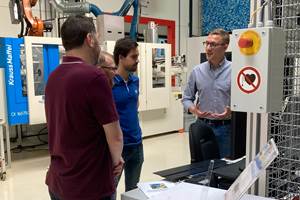Shared material databases: The next chapter
John Tomblin, Ph.D., is the executive director of the National Institute for Aviation Research (NIAR) at Wichita State University in Kansas. For 10 years, he has worked in the area of general aviation material qualification and, primarily as chairman of NASA's Advanced General Aviation Transport Experiments (AGATE)
Unlike metals, whose properties can be known independent of the structures in which they are used, composite properties are to a significant extent determined as they are manufactured into a structure. The ratio of fiber and resin, orientations of fibers, the ply schedule, the selected fabrication process and process parameters all have their effect on the ultimate performance, which cannot be known until the part is cured and subsequently tested.
Historically, this fact has made the process of qualifying a composite material system for use on aircraft much more time consuming, difficult and expensive than qualifying metals. Each aircraft manufacturer had to conduct its own qualification process. Even if a "new" composite material was identical to one already approved for use on an aircraft built by another company, the fabrication techniques and testing processes used for the previous aircraft application were unknown and, therefore, could not be duplicated. The company was required to develop its own procedures for structural testing, manufacturing control and repair — a process that could consume up to five years and cost millions of dollars. While this was cumbersome for large commercial aircraft OEMs, it was relatively easy to cost-justify. But for the smaller general aviation manufacturer, the process imposed a huge penalty, driving up the cost of individual aircraft and ultimately limiting aircraft sales.
In recent years, NASA, the U.S. Federal Aviation Admin. (FAA) and the aerospace industry, through Military Handbook 17 (MIL-HDBK-17) and the NASA-conceived Advanced General Aviation Transport Experiments (AGATE) program, have worked together to reduce the qualification burden imposed on individual aircraft manufacturers. In my opinion, AGATE is one of the most successful public/private cost-sharing partnerships ever conceived, bringing together academia, the FAA, other government agencies and industry to develop affordable new technologies and accompanying industry standards and certification methods for airframe, cockpit and flight training systems for next-generation single-pilot, four-to-six seat, near all-weather light airplanes. One of the contract reports written for AGATE evolved into an FAA policy (Policy Statement Number ACE-00-23.613-01; Vol. 65, No. 114) and is referenced in composite aircraft presently being certified by the FAA and will have an impact on composite certifications of small aircraft in the future.
The AGATE partners helped establish certification standards for composite materials and created a series of composite material databases that revolutionized the way in which they are certified and used on aircraft. The result was what is now known as the AGATE methodology, a more cost-effective concept that shifts the major responsibility for qualification and testing from the aircraft manufacturer to the material supplier. The latter works to pre-approve a material and creates material qualification databases that are then made available to aircraft manufacturers. Through these databases, a manufacturer can select an approved material without having to define and implement its own qualification procedures, since the materials in the database have been manufactured in accordance with material specifications, which impose control of the key physical, chemical and mechanical properties, and must be manufactured in accordance with a specification that controls key processing parameters. The manufacturer now must perform only a smaller subset of the tests originally used by the material supplier, to show that the company's manufacturing procedures produce properties substantially equivalent to those identified in the original data set.
The AGATE method has been used to create shared databases for a select group of materials from Toray Composites America, Cytec Engineered Materials, FiberCote, Advanced Composites Group, Hexcel and Newport Adhesives & Composites. Many are now employed on active aircraft programs and their use has spared OEMS great expense. There is, however, much left to do to ensure that what began with AGATE comes to full fruition. First, there are many materials from these suppliers and other sources for which shared databases are not yet available. These include new and innovative material forms whose utility and cost-efficiency in aircraft may exceed that of materials for which shared databases now exist. Secondly, there is concern about materials for which shared databases already exist, in terms of their long-term, shipment-to-shipment stability, especially in aircraft programs where the production period may span a number of years. Once a material is qualified, the aircraft manufacturer must typically establish a quality assurance department to test and verify that incoming materials have been produced within tolerance. Moreover, if the material supplier changes, for example, the hardener used in its FAA-approved prepreg, it raises questions of equivalency.
Answering these and other questions is the mission of the NASA National Center for Advanced Material Performance (NCAMP), a newly created national center for composite material validation and quality assurance, which will be located within the National Institute for Aviation Research (NIAR) at Wichita State University (Wichita, Kan.). ( September 2004 HPC See ).
In practical terms, NCAMP will seek to implement a continuous approach to material qualification. NCAMP facilities and expertise will be available to material suppliers and interested aircraft OEMs who wish to participate in coordinated efforts to test, qualify and create shared databases for new materials. In addition, NCAMP will provide a collective means for continuously monitoring approved materials, to ensure their stability over time. Each participant will share a portion of the cost, saving individual manufacturers the much greater expense and trouble of diverting resources to perform their own quality checks on incoming material.
In an era when both airlines and aircraft manufacturers are investigating extreme methods to reduce costs and increase operational efficiency through the use of new materials and innovative manufacturing methods, the NCAMP initiative is a critical next step. The time saved in the development cycle of a new aircraft model is directly proportional to the total unit cost savings and direct operational cost (DOC). Unless new composites technology becomes as accessible to the engineering community as metals, the total DOC benefits are lost. In order to optimize the benefits of using an advanced material, the material must approach the supply stability of an equivalent metallic material. Traditionally, composite material properties values are not stabilized prior to finalizing the design. This is one of the most adverse situations encountered in any program, in which the true characteristics of the material are treated essentially as an unknown, resulting in overly conservative designs that tend to negate much of the benefit of using an advanced material form. NCAMP will seek to provide a program in which material properties will be stabilized prior to initial design. This NASA effort will coordinate with international groups (MIL-HDBK-17, SAE and ASTM International) as well as the FAA and the U.S. Department of Defense (DoD).
NCAMP is ideally suited to address the changing needs of not only general aviation, but also NASA's new missions and the infant commercial spacecraft industry, highlighted by SpaceShipOne's recent capture of the X-Prize ( November 2004 HPC see ). With recent advances in science and engineering, there are many emerging technologies that will likely accelerate the development of aerospace vehicle performance during the next decade. Strategic integration of these technologies will provide for the next major gains in vehicle performance. NCAMP, with its collaborative, shared funding approach and central location, will be an efficient, affordable provider of expert advice, safety review and external multidisciplinary critical design review analysis, enabling the composites industry to leapfrog the current evolutionary progress in the development of advanced aerospace technology.
Related Content
Women in the Composites Industry brings together women for networking, educational opportunities
Aiming to support the growth of women in this industry, the WCI industry group and its partners recently held its first live training event hosted by Owens Corning.
Read MoreUniversity of Sheffield researchers to drive structural health monitoring in U.K. infrastructure
The £7.7 million program, ROSEHIPS, anticipates exploitation of machine learning, sensing and digital twin technology for automated health monitoring in infrastructure, such as bridges, telecoms masts and wind turbines.
Read MoreASCEND program update: Designing next-gen, high-rate auto and aerospace composites
GKN Aerospace, McLaren Automotive and U.K.-based partners share goals and progress aiming at high-rate, Industry 4.0-enabled, sustainable materials and processes.
Read MoreTPRC training courses target thermoplastic composites
Three upcoming in-person thermoplastic composites courses, ranging from entry-level to advanced, are organized to enhance composites professionals’ knowledge in this burgeoning field.
Read MoreRead Next
Composites end markets: Energy (2024)
Composites are used widely in oil/gas, wind and other renewable energy applications. Despite market challenges, growth potential and innovation for composites continue.
Read MoreFrom the CW Archives: The tale of the thermoplastic cryotank
In 2006, guest columnist Bob Hartunian related the story of his efforts two decades prior, while at McDonnell Douglas, to develop a thermoplastic composite crytank for hydrogen storage. He learned a lot of lessons.
Read MoreCW’s 2024 Top Shops survey offers new approach to benchmarking
Respondents that complete the survey by April 30, 2024, have the chance to be recognized as an honoree.
Read More













.jpg;maxWidth=300;quality=90)















